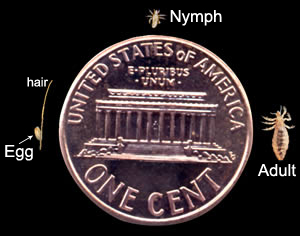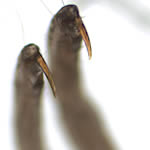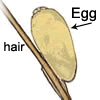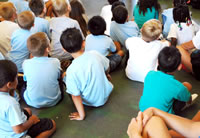 |
| Head lice are small, wingless insects that are hard to see. |
| Photo by CDC |
The Facts of Lice
Head lice are small wingless insects. They look like walking, light grey sesame seeds, and have six pincer-like claws.
Head lice infest people's hair and suck blood from their scalps.
Anyone can get head lice but head lice most often infest school children. Because they are small and grab tightly onto hairs, head lice are hard to see. "Nits" (their eggs) are easier to see. Female lice glue the nits directly onto the hair shaft next to the scalp. Nits are found anywhere on the head, most often at the nape of the neck and behind the ears, but also in eyebrows and eyelashes.
Head lice do not transmit any diseases but they often cause itching and discomfort.
 |
 |
 |
| Adult head louse | Close up of head louse claws | The nit or egg is glued onto a hair |
| All three photos by CDC |
There is a lot of misinformation about head lice. For example, it used to be thought that children spread head lice mainly by sharing their combs, brushes, hats, scarves, head rests, etc., but it turns out that lice move onto new heads mainly from prolonged head-to-head contact.
Likewise, many believe that you can easily "catch" head lice from blankets, pillows, and couches. But, while possible, this is very unlikely. Head lice dry out and die very quickly when they are no longer on a scalp. Head lice on a blanket are almost always dead...or soon will be.
Cutting a child's hair for lice control is now thought unnecessary. According to one British researcher, cutting the hair short just makes it more likely that lice will move onto another child's head!
 |
| There are significant policy disputes on how best to deal with head lice in schools |
Photo © Renee Lee/iStockphoto |
School Policies
There is also disagreement about how to best deal with head lice in a school.
The National Pediculosis Association, recommends a "no nit" policy as the public health standard intended to keep children lice-free, nit-free, and in school. With this policy, every single nit must be removed before a child can return to school. But other experts say that this is not necessary. According to the American Academy of Pediatrics, a "no nit" policy isn't sensible because nits are only viable (able to hatch) when they are less than a quarter of an inch from the scalp. Farther away, and the nits are just old egg shells still clinging to the hair, or they are dead.
It has been common school policy for years that if head lice or nits are found in a student's hair then (1) that child must be sent home immediately, and (2) other parents of students at the school would be informed by letter that head lice have been found. But others disagree with this aggressive policy, and recommend that school action be limited to informing the parents of the infested child.
Detection
The best and most effective way to find head lice is by "wet combing." Wet combing involves washing the hair and applying conditioner, then combing through with an ordinary comb to remove tangles. A fine tooth detection comb is then pulled downwards through the hair, a section at a time, keeping the comb close to the scalp. The comb is checked for lice after each section.
If head lice are found, other family members and classmates should be checked. Checks should be continued following any scalp treatment to ensure that it has been effective and to detect any reinfestation.
The Centers for Disease Control (CDC) has extensive information on head lice on their website. To leave Techletter.com and go there, click CDC.
